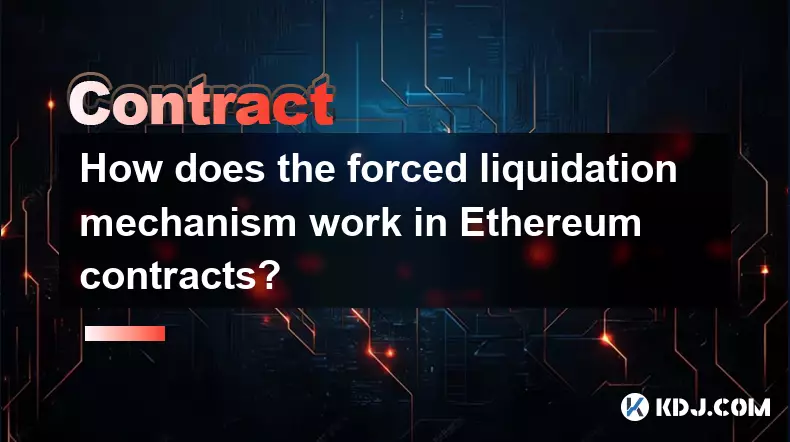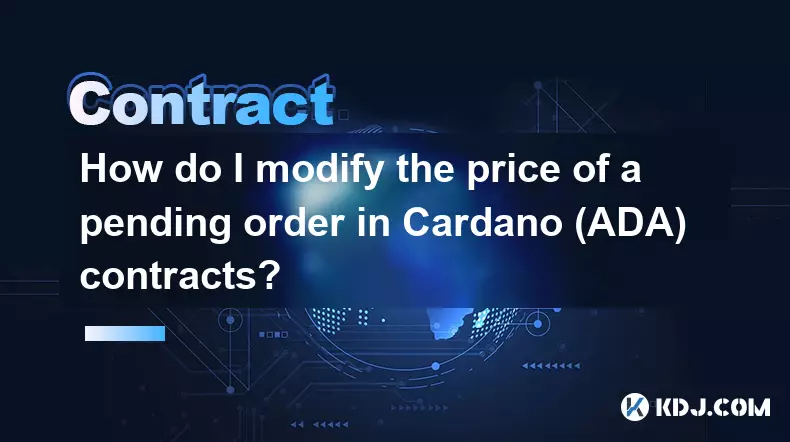-
 bitcoin
bitcoin $109523.663807 USD
-0.13% -
 ethereum
ethereum $4019.526508 USD
2.06% -
 tether
tether $1.000482 USD
0.00% -
 xrp
xrp $2.776815 USD
0.18% -
 bnb
bnb $958.942396 USD
0.12% -
 solana
solana $204.294698 USD
3.84% -
 usd-coin
usd-coin $0.999693 USD
0.00% -
 dogecoin
dogecoin $0.232115 USD
2.09% -
 tron
tron $0.338028 USD
0.84% -
 cardano
cardano $0.790920 USD
1.50% -
 hyperliquid
hyperliquid $44.871443 USD
5.60% -
 ethena-usde
ethena-usde $1.000322 USD
0.04% -
 chainlink
chainlink $21.034165 USD
2.60% -
 avalanche
avalanche $28.794831 USD
-0.54% -
 stellar
stellar $0.360466 USD
1.24%
How does the forced liquidation mechanism work in Ethereum contracts?
Forced liquidation in Ethereum DeFi occurs when collateral value drops below a threshold, triggering automated, on-chain debt repayment by liquidators for discounted assets.
Sep 27, 2025 at 08:19 am

Understanding Forced Liquidation in Ethereum-Based DeFi Protocols
1. Forced liquidation in Ethereum smart contracts primarily occurs within decentralized finance (DeFi) lending platforms such as Aave, Compound, and MakerDAO. These systems allow users to borrow assets by locking up collateral, usually in the form of cryptocurrencies like ETH or stablecoins. When the value of the collateral drops below a predefined threshold—known as the liquidation threshold—the position becomes vulnerable to liquidation.
2. The mechanism relies on price oracles to monitor the real-time market value of the collateral. Oracles feed data into the smart contract, which continuously assesses the health factor of a user’s loan. If the health factor falls below 1.0, it indicates that the loan is undercollateralized, triggering eligibility for liquidation.
3. Any participant in the network can act as a liquidator. They repay a portion of the borrower’s outstanding debt, typically around 50%, and in return, receive the borrower’s collateral at a discounted rate. This discount, known as the liquidation penalty, serves as an incentive for liquidators to maintain system solvency.
4. The transaction is executed through a function call in the protocol’s smart contract. Once initiated, the contract automatically transfers the collateral to the liquidator and reduces the borrower’s debt accordingly. This process happens trustlessly and transparently on-chain, with all actions governed by immutable code.
5. After partial repayment, the remaining loan balance stays with the borrower, who must either deposit more collateral or repay further to avoid additional liquidations. In some protocols, repeated drops in collateral value may lead to multiple liquidation events until the position is fully settled or restored to a healthy state.
The Role of Collateral Ratios and Thresholds
1. Each DeFi platform sets specific loan-to-value (LTV) ratios that determine how much a user can borrow relative to their deposited collateral. For example, an LTV of 75% means a user can borrow up to 0.75 worth of value for every 1 unit of collateral deposited.
2. The liquidation threshold is set slightly below the maximum LTV—often between 80% and 85%—to create a buffer zone. If the market moves quickly, this buffer helps prevent immediate liquidation but does not eliminate risk during extreme volatility.
3. Different assets carry different risk parameters based on their volatility. Stablecoins usually have higher LTVs due to low price fluctuation, while highly volatile tokens like meme coins may be excluded from collateralization entirely or assigned very conservative thresholds.
4. Users are expected to monitor their positions actively or use third-party services that provide alerts when their health factor approaches critical levels. Failure to respond promptly often results in forced liquidation, especially during flash crashes or rapid market swings.
5. Some advanced interfaces integrate automated bots that help users rebalance their portfolios by topping up collateral or repaying debt before thresholds are breached, minimizing exposure to forced sales.
Incentive Structures for Liquidators
1. Liquidators play a crucial role in maintaining the financial integrity of DeFi lending markets. By stepping in during undercollateralized states, they ensure that protocols do not incur bad debt.
2. The primary incentive comes from the liquidation bonus, typically ranging from 5% to 15%. This means a liquidator acquires $1,000 worth of ETH by repaying only $900 of debt, assuming a 10% bonus. The exact percentage varies per asset and platform.
3. Because liquidation transactions are permissionless, anyone with sufficient capital and technical capability can participate. This has led to the rise of specialized liquidation bots that scan the blockchain continuously for vulnerable positions.
4. These bots operate with minimal latency, often using private mempools or Flashbots to front-run potential competitors and secure profitable opportunities before prices shift further.
5. While beneficial for system stability, high-frequency bot activity can exacerbate short-term price drops, especially if large positions are liquidated rapidly, creating cascading effects across interconnected markets.
Frequently Asked Questions
What triggers a liquidation event in Ethereum-based lending platforms?A liquidation is triggered when the value of a borrower’s collateral falls below the required threshold due to market price changes, causing the loan’s health factor to drop beneath 1.0. Price oracles detect this imbalance and enable external actors to initiate the liquidation process via a smart contract function call.
Can a partially liquidated position still be recovered by the borrower?Yes, after a partial liquidation, the borrower retains the remaining debt and any leftover collateral. They can restore the position’s health by depositing additional collateral or repaying part of the debt. As long as the health factor rises above 1.0, no further liquidation will occur.
Are there risks associated with being a liquidator?Liquidators face execution risk, including failed transactions due to slippage or gas competition. They also assume temporary exposure to asset volatility between the time they repay debt and when they receive collateral. In fast-moving markets, the received asset might immediately decline in value post-acquisition.
How do decentralized oracles impact liquidation accuracy?Oracles such as Chainlink provide timely and tamper-resistant price feeds essential for accurate collateral valuation. Delays or manipulation in oracle data could result in premature or unjustified liquidations. Most protocols implement heartbeat checks and deviation thresholds to mitigate inaccurate pricing during anomalies.
Disclaimer:info@kdj.com
The information provided is not trading advice. kdj.com does not assume any responsibility for any investments made based on the information provided in this article. Cryptocurrencies are highly volatile and it is highly recommended that you invest with caution after thorough research!
If you believe that the content used on this website infringes your copyright, please contact us immediately (info@kdj.com) and we will delete it promptly.
- Sleep Token's Macabre Metal: A Ritualistic Rise to Rock Stardom
- 2025-09-27 22:25:15
- BlockchainFX: Is This Presale the Next Binance?
- 2025-09-27 22:25:15
- ORDER Token's Binance Listing Ignites Crypto Rally: What Traders Need to Know
- 2025-09-27 22:30:01
- Ethereum ETFs Feel the Heat: Investors Exit as Staking Approval Looms?
- 2025-09-27 22:30:01
- Crypto Presales & Meme Coins: Hunting for the Next 100x Opportunity
- 2025-09-27 22:30:01
- Cardano (ADA) Price Prediction: Bullish Scenarios and Market Dynamics
- 2025-09-27 22:30:16
Related knowledge

How do I enable the "scalping-only" mode for Cardano (ADA) contracts?
Sep 24,2025 at 03:19am
Understanding Scalping Strategies in Crypto Derivatives1. Scalping in cryptocurrency trading refers to executing multiple short-term trades within min...

How do I add margin to Cardano (ADA) contracts?
Sep 27,2025 at 07:54pm
Understanding Margin in Cardano (ADA) Smart ContractsCardano operates on a proof-of-stake blockchain that supports smart contracts through its Plutus ...

What is the maximum position limit for Cardano (ADA) contracts?
Sep 23,2025 at 11:00pm
Understanding ADA Futures and Derivatives Market Structure1. Cardano (ADA) futures contracts are offered by several major cryptocurrency derivatives e...

What is the maker fee for Cardano (ADA) contracts?
Sep 26,2025 at 09:01am
Understanding Maker Fees in Cardano (ADA) Contracts1. The concept of maker fees applies broadly across decentralized exchanges and smart contract plat...

How can I view open interest in Cardano (ADA) contracts?
Sep 24,2025 at 07:36am
Understanding Open Interest in Cardano Derivatives1. Open interest refers to the total number of outstanding derivative contracts, such as futures or ...

How do I modify the price of a pending order in Cardano (ADA) contracts?
Sep 27,2025 at 01:00am
Understanding Pending Orders in Cardano Smart Contracts1. Cardano operates on a proof-of-stake blockchain that supports smart contracts through its Pl...

How do I enable the "scalping-only" mode for Cardano (ADA) contracts?
Sep 24,2025 at 03:19am
Understanding Scalping Strategies in Crypto Derivatives1. Scalping in cryptocurrency trading refers to executing multiple short-term trades within min...

How do I add margin to Cardano (ADA) contracts?
Sep 27,2025 at 07:54pm
Understanding Margin in Cardano (ADA) Smart ContractsCardano operates on a proof-of-stake blockchain that supports smart contracts through its Plutus ...

What is the maximum position limit for Cardano (ADA) contracts?
Sep 23,2025 at 11:00pm
Understanding ADA Futures and Derivatives Market Structure1. Cardano (ADA) futures contracts are offered by several major cryptocurrency derivatives e...

What is the maker fee for Cardano (ADA) contracts?
Sep 26,2025 at 09:01am
Understanding Maker Fees in Cardano (ADA) Contracts1. The concept of maker fees applies broadly across decentralized exchanges and smart contract plat...

How can I view open interest in Cardano (ADA) contracts?
Sep 24,2025 at 07:36am
Understanding Open Interest in Cardano Derivatives1. Open interest refers to the total number of outstanding derivative contracts, such as futures or ...

How do I modify the price of a pending order in Cardano (ADA) contracts?
Sep 27,2025 at 01:00am
Understanding Pending Orders in Cardano Smart Contracts1. Cardano operates on a proof-of-stake blockchain that supports smart contracts through its Pl...
See all articles









































































